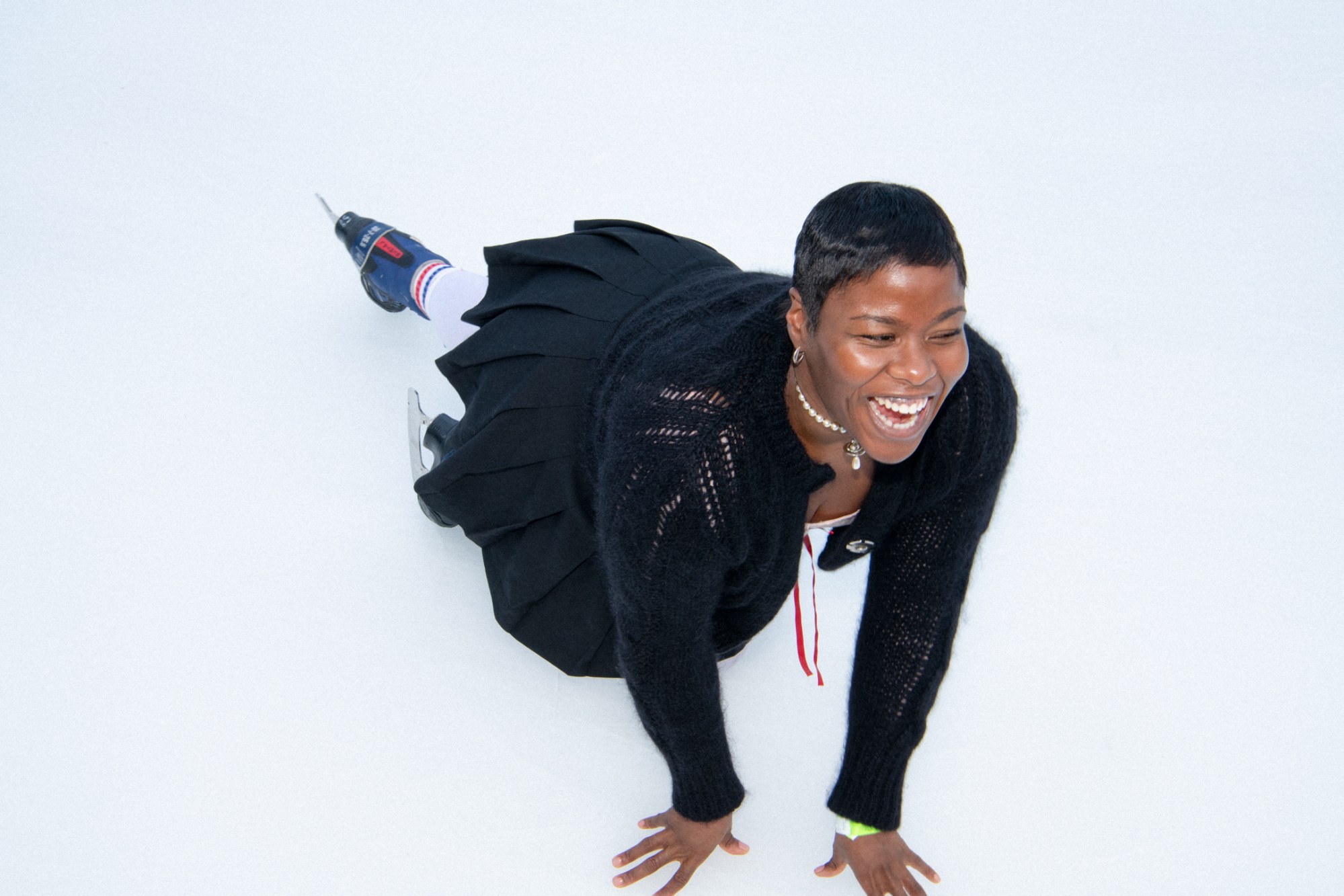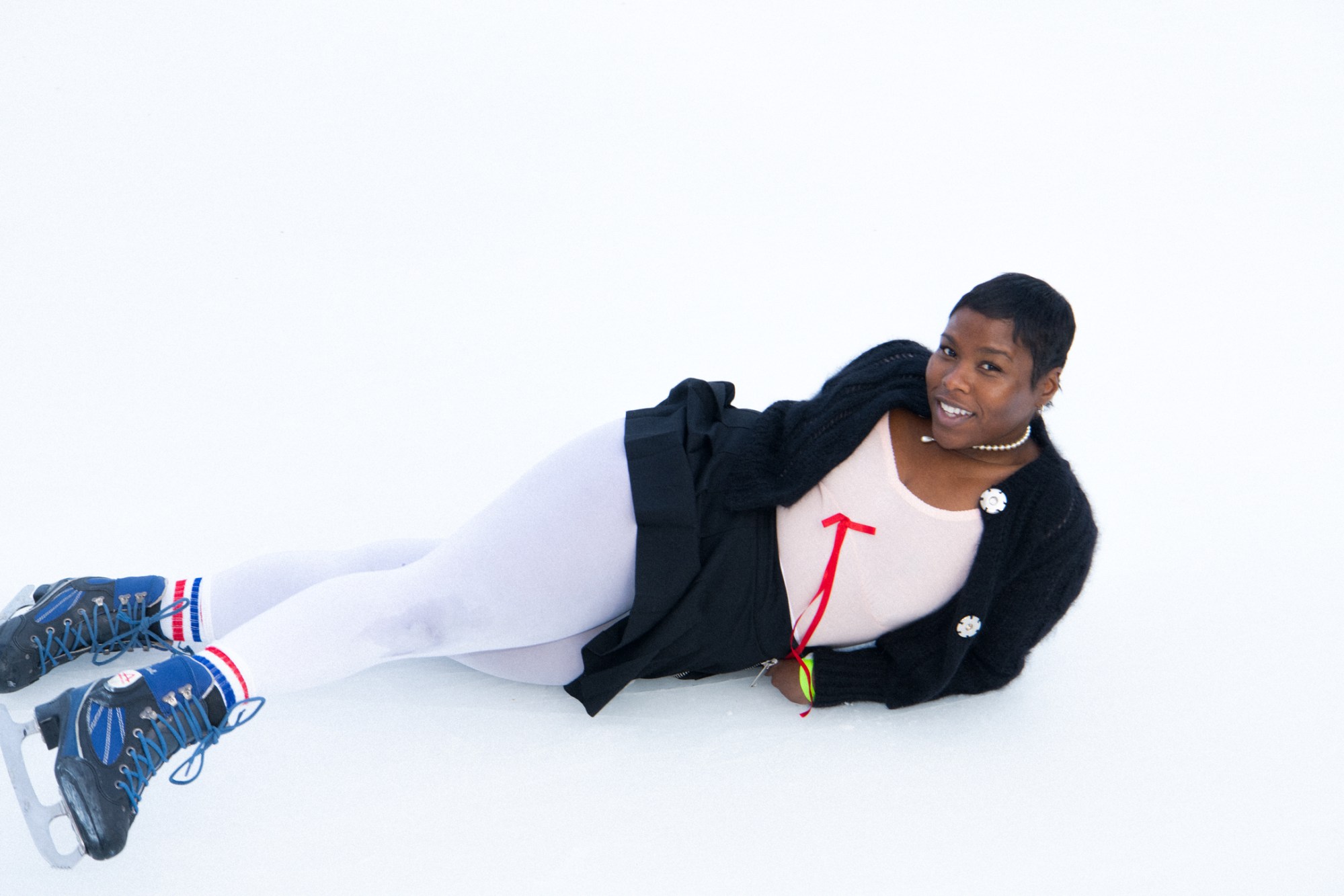“Everyone was falling over,” Precious Okoyomon says. “It was so perfect but so insane, because my body had never felt anything like that before; the intense cold, the wind knocking you over repeatedly. I felt like I had no gravity.” The New York artist is reflecting on installing their latest work, “Fragmented sky – wind – fly – giving presence to wind”, a collaborative project with Dozie Kanu for Reykjavik’s Sequences Festival. Taking over Grótta lighthouse on the tip of Iceland’s Seltjarnarnes Peninsula – a place only accessible twice a day during low tide, with black sand, masses of seaweed and a rugged shoreline – the duo battled harsh conditions to string ropes of 600 bells along the beach and up into the beacon itself. “They had the idea of harnessing the tide and the wind; the forces of nature,” says Sten Ojavee, one of four curators working on the biennial for 2023, who describes the installation as “more of a journey” than a traditional artwork. “You go there alone, you walk this path with the bells, you hear the wind. It’s very physical. It represents Icelandic subconscious to me, in a poetic way, because it’s harsh but beautiful at the same time. It’s really this dualistic thing.”
As visitors climb the many steps of the lighthouse, a sound recording of the howling wind and clanging bells, captured on the night of installation, plays along with a poem written by Precious called “Weather Report”. It’s different to their usual work, which typically involves building whole ecosystems – 2021’s garden of invasive plants on a rooftop in Aspen; a toxic, butterfly-laden hot house in a deconsecrated ninth-century chapel in Italy (with an original composition by their friend Kelsey Lu, no less) this past summer. Two years ago Precious won the prestigious Frieze Artist Award, praised for their “simultaneously playful and critically inquisitive” vision.
The eleventh instalment of Sequences opened last month under the curatorial guidance of Sten, along with Marika Agu, Maria Arusoo and Kaarin Kivirähk – all from the Estonian Centre for Contemporary Art in Tallinn. The theme of this edition is “Can’t See”, an opportunity to explore the growing threat of ecological destruction through original and existing work by artists living and dead that delves – literally and metaphorically – into the depths of the sea and soil. The work is displayed across local institutions including The Living Art Museum, the Icelandic National Gallery, Kling & Bang, and The Nordic House; as well as on location, in the grounds of The Reykjavik EDITION and, as with Precious and Dozie’s work, in the nearby lighthouse.
Eager to discover more about the project, we spoke to Precious about the magic of Iceland, why they’re currently something of “a chaos bunny”, and the epic task of preparing for Venice 2024, where they’re exhibiting as part of the Nigerian Pavilion group show.

Hi Precious. Congratulations on Sequences! Had you visited Iceland before this?
I hadn’t. They asked me to do Sequences and I feel like there’s a certain magic there, the way the Earth is very present – the wind, the intensity of how it doesn’t get dark in the summertime – so I was like, of course I wanna do this! I’ve always wanted to collaborate with Dozie too, so we went to Iceland together and I was so enthralled by the wind. And that’s kind of how it started. I was obsessed with the idea of responding to the wind.
Were you guided by the site in particular?
Yeah, I saw the lighthouse and was just so in love with it. It was a really beautiful sunny summer’s day that we first visited and there were all of these birds flying around – you had to duck to not get attacked by them. It was really chaotic and beautiful. And then, when we went back to Iceland to install, we were trying to hang up the bells and the wind was knocking me over and there was a point where I just had to submit and lay in the grass between the lighthouse and the sea. The wind was just moving me around as I laid in the grass and I was like: yes, this is it. It was so simple and I just wanted to talk to the Earth. I felt really connected to it. I was like: thank you wind for blowing me over. Being physically knocked over by the wind is such a humbling thing; to be wrung by the Earth. It just made sense to try and echo that in this way.
This is a different kind of installation for you, right? You’re usually using natural elements as materials to build with, whereas here you’re harnessing them.
This is more soft; a real relationship with the environment. I just felt like there was no intervention here for me other than talking to the Earth.
Dozie walked visitors through the lighthouse on opening weekend and noted that the project had evolved over time – something that the curator Maria echoed as well, saying that “nature edited this work”. What other challenges did you face?
The concept we started out with was that we wanted to have these buoys in the ocean, and the bells would be tied between the buoys and up to the lighthouse. But it became complicated because the fisherman couldn’t attach the buoys to the bottom of the ocean and so the wind would’ve blown them about too much. You really had to work with the elements here because they’ll just overpower you. My whole practice is collaborating with nature, but this time nature was like: no, you can’t do that. And I’m one who likes to listen. So we were like, ok, we’ve just got to go for simplicity here.
I just love the sound; each bell has its own tone – everything from sheep bells to little prayer bells. They all ring in their different ways, so there’s always a different song being played. The wind changes and you change with it. The whole thing became a ritual because I was so aware of the tide. That’s what got me at first, the fact that the tide controlled this area; that you couldn’t go at certain times.

You use the word ritual to describe the process and that’s really felt when climbing the stairs of the lighthouse, the bells ringing like a summoning of some kind. It’s something Dozie likened to an ascension to heaven.
I personally feel like I’m in this place where I’m constantly in motion and making all these things and trying to stay grounded without the emotional and intellectual chaos of the world, you know? And this piece felt very like a prayer in the sense of reducing the noise of the world back to a humbling of the Earth and of self. Being knocked over by the wind and the bells as you move your body up the steps; the bells ring but also knock back at you. In that ritual of movement and falling and getting back up, I was very inspired by this Anne Boyer poem I’d been reading a lot. I actually read it on the plane to Iceland, it’s called “What resembles the grave but isn’t”. It’s one of my favourites. And it felt like this was everyone, together, picking up the rope and the bells and falling together, then picking things up again. Also playing with Dozie in this way where we just wanted to make a really special prayer in Iceland – and together we did it! That was the ritual and the beauty of it. I’m really into having space to fragilise; it’s what I’m always trying to create. I feel like we got a little closer to that here.
If the artwork is a prayer, what’s it a prayer for?
It’s a prayer to remember to be humbled by the Earth. To be ringing, to be falling, getting up, falling again. To be ringing, to be endlessly ringing. To be a vessel for the ringing.
Looking at the bigger picture now, it’s been a non-stop few years, with what seems like the entire art world falling for you in the process. Is there anything you wish you had known before entering that world?
I’m just grateful that the energy I put out into the world is received with such grace and love. I’m happy that I have grounding and the people who love and support me see me and understand the submission to the black compost of my love. The only thing I wish I knew was soft and steady no’s. I’m learning slowly.
And what’re you working on at the moment? What’s next for you?
Ugh, so much all the time all at once. I’m doing the Thailand Biennale in Chiang Rai that opens on 10 December. I’m super excited for that, which works with ash from the sugarcane fields, and the leftover ash I’ve had from burning several invasive installations. I’m doing the Nigerian Pavilion group show in Venice in 2024 too – that’s super exciting. I’m making a radio tower that’s played by the wind. I’m just really excited for all my new projects. I’m having a lot of fun being a chaos bunny.
Artworks from Sequences: Can’t See will be on display across Reykjavik until December 2023.
Credits
Photography Shawna Ferreira

